CNBC/Change Research Poll in Arizona, Florida, Michigan, North Carolina, Pennsylvania, and Wisconsin: May 15-17, 2020
Key Takeaways
- 66% of battleground voters are seriously concerned about COVID-19, 42% believe things are getting better, and 41% say they are getting worse – all stable since early May.
- Voters still prioritize the health impact of COVID-19 over financial concerns (64% to 36%); 58% are favorable towards mask-wearers, only 39% are favorable towards stay-at-home protests.
- 81% say there is at least a 50% chance of a second wave this year, they are most likely to blame it on Trump (44%) and states reopening too soon (37%), not China (22%)
- 51% disapprove of Trump’s handling of COVID-19 in the battleground states, and he and Biden are statistically tied in terms of trust to handle this outbreak and recovery.
COVID concerns are stable as voters watch reopenings and wait
Voters remain split over the impact of the coronavirus, with 42% saying things are getting better, 41% saying they are getting worse and 17% unsure; this is stable from 2 weeks ago (40% better, 43% worse, 17% not sure).
Two-thirds of battleground voters are seriously concerned about coronavirus and 42% are very seriously concerned. That is stable from 2 weeks ago when 68% were seriously concerned and 45% were very seriously concerned.
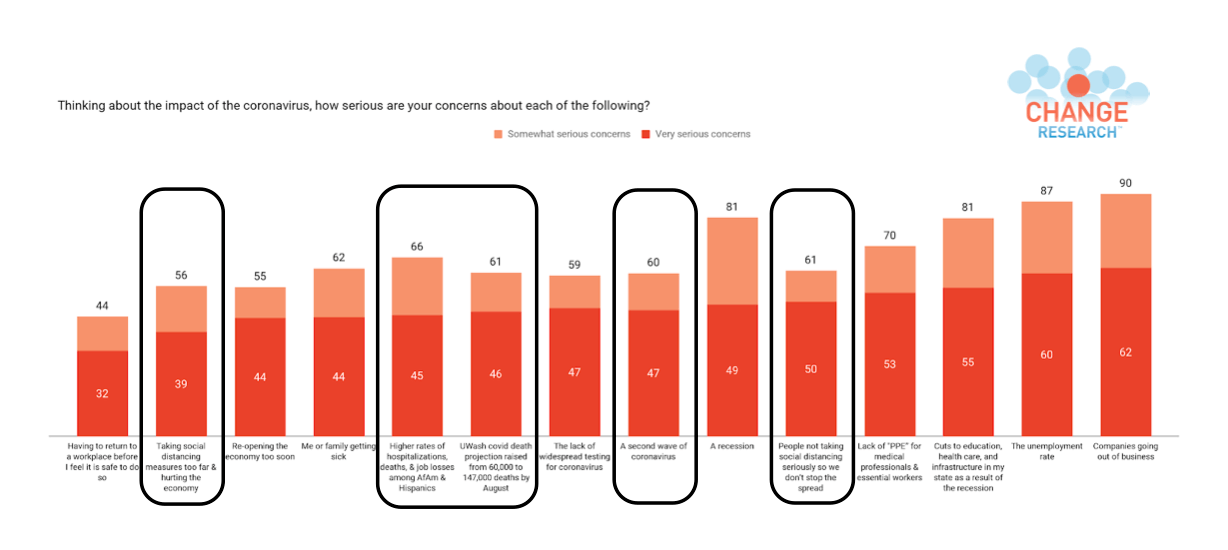
Voters continue to be most seriously concerned about companies going out of business (90% serious concerns, 62% very serious), the unemployment rate (87% serious, 60% very serious), and cuts to state programs like education, healthcare and infrastructure in their state as a result of the recession (81% serious, 55% very serious). However, in a forced choice about their immediate concerns, voters continue to prioritize the impact of COVID on health and safety over the impact on finances at both the personal level (64% to 36%) and the national level (57% to 43%), as they did in early May.
The top COVID related concerns are people not taking social distancing seriously so we don’t stop the spread (61% serious, 50% very serious), the increasingly higher death toll projections (61% serious, 46% very serious), and themselves or a family member getting sick (62% serious, 44% very serious). Respondents are less concerned about taking social distancing measures too far and hurting the economy (56% serious, 39% very serious).
Even as states start to loosen restrictions, majorities are still taking precautions in response to the outbreak such as washing their hands (90%), social distancing (79%), avoiding crowds (71%), wearing a mask in public (68%), not going to bars and restaurants (65%), and sheltering at home (57%). These responses are driven by Democrats and independents. Republicans are far less likely to participate in precautions.
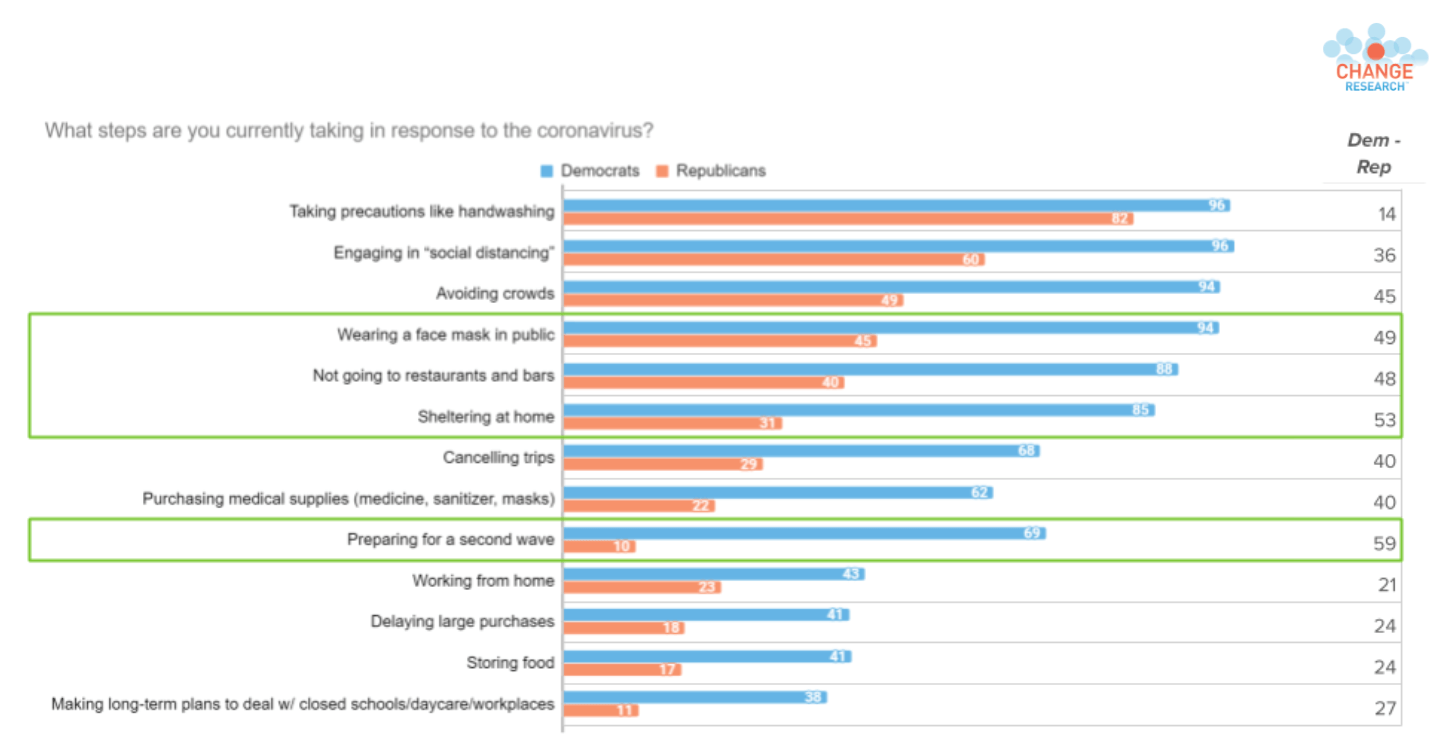
A 58% majority of voters are favorable towards those who wear masks in public, while the majority are unfavorable towards people protesting stay-at-home orders (52% unfavorable).
Communities of color are bearing the greatest burden of health and economic impacts
Communities of color and low wage workers are bearing the greatest health and economic burden of COVID-19 and 66% of voters are seriously concerned about the “higher rates of hospitalizations, deaths, and job losses among African Americans and Hispanics.”
Two-thirds of African Americans, 59% of Latinx voters, and 47% of those with household incomes less than $50,000 a year know someone who has contracted the coronavirus. A shocking 42% of African Americans, 47% Latinx voters, and 41% of those making less than $50K live in households that have lost jobs or been furloughed. Job losses are much lower among white voters (34%) and those making $50-100K (35%) or more (33%). Similarly, over half of African Americans (52%), Latinx voters (58%), and low-wage workers (52%) live in a household that has lost wages or taken a salary cut as a result of COVID, compared to 46% of white voters and roughly 45% of those in higher income households.
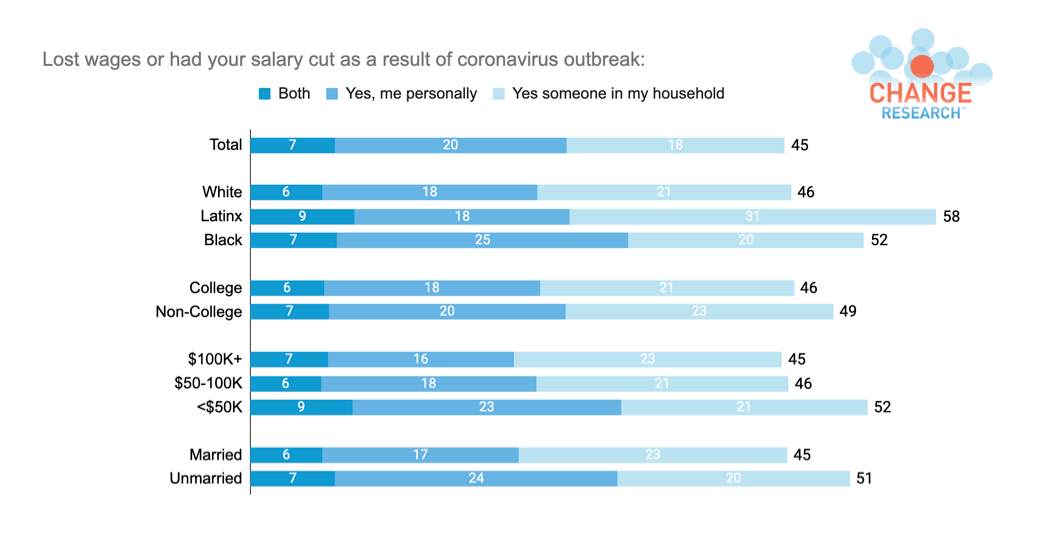

Among white voters, the white college women and the white non-college women are also more likely than their male counterparts to report a lost job, lost wages, or knowing someone with COVID-19. Though white college men are no more likely to report a financial impact than white working class men, they are more likely to have a personal connection to people suffering from coronavirus.

These people of color and white college women are the core of the Democratic Party, while white working class men are the core of the GOP. The differential impact may help to explain some of the polarization in the responses to key measures in this survey.
Voters fear a second wave and would blame Trump and states reopening most
A 55% majority of voters in the battleground are seriously concerned about reopening the economy too soon and a 48% plurality say the state reopening their economies are doing so too quickly. Only 28% say these states are not reopening quickly enough.
Donald Trump is the person least trusted to make decisions about reopening the economy (just 50% trust a lot or some). People trust doctors and medical professionals (79% a lot or some), Dr. Fauci (59%), and their own employers (76%) the most to make those choices.
As states begin to reopen, six-in-ten battleground voters are seriously concerned about a second wave of COVID. A 57% majority say a second wave will definitely or probably happen this year, and 81% say there is at least a 50-50 chance there will be one. The people they would most blame for failing to prevent a second wave are Donald Trump (44%) and states reopening too soon (37%). Republicans are most likely to blame China (43%) and Democrats (35%) for failing to prevent a second wave, even though it is Democrats and blue states who are social distancing the most.

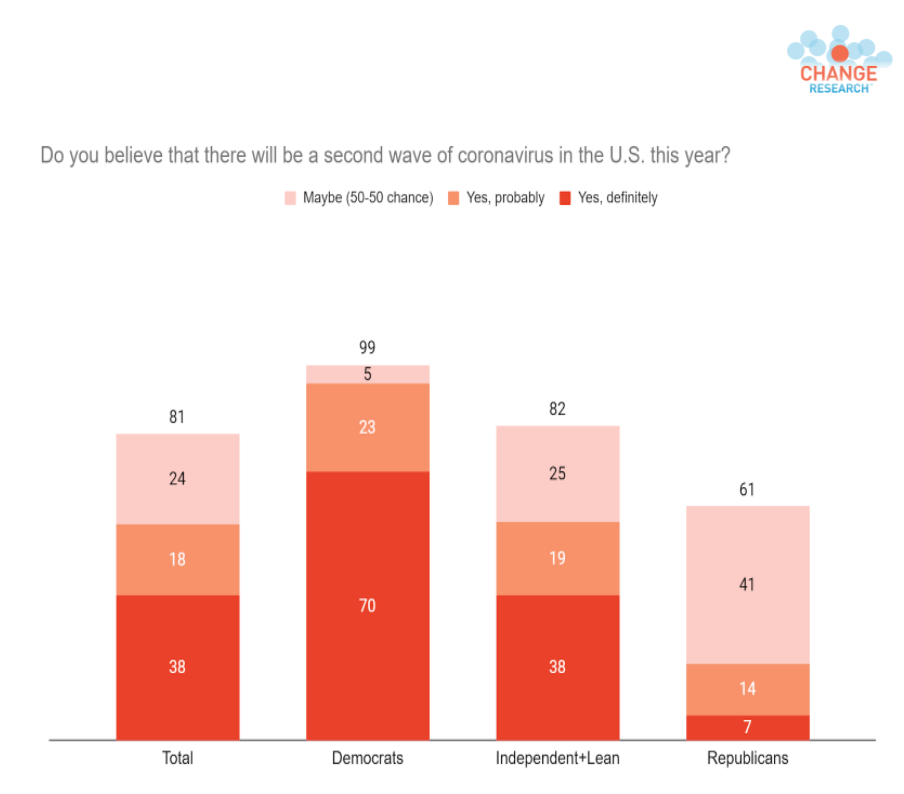
Biden still needs to win over likely voters on COVID response and recovery
A 51% majority of battleground voters give Trump a negative score for his handling of the coronavirus. When asked how they would describe his approach to the coronavirus, the word they use most often is ‘incompetent.’
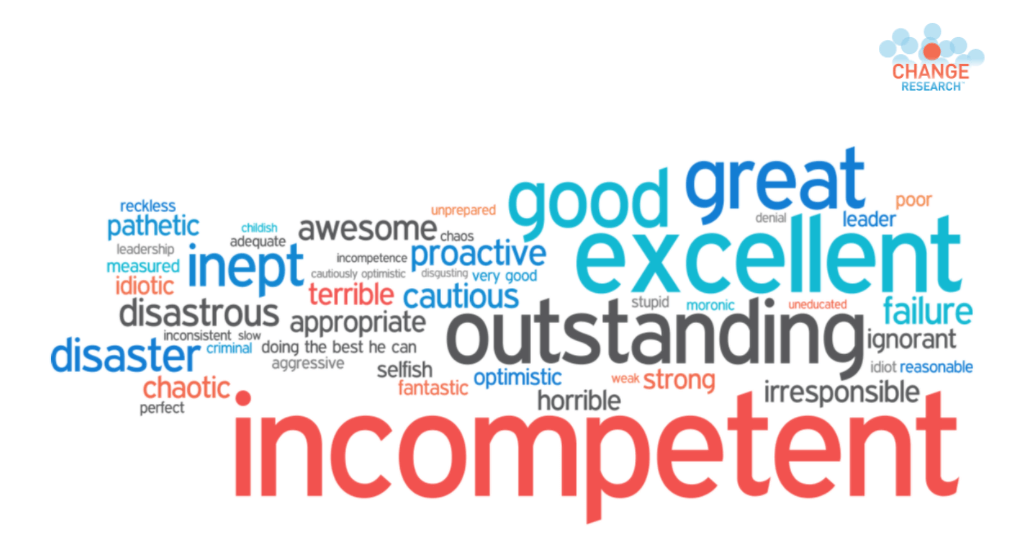
That does not necessarily mean these voters in the battleground prefer Joe Biden, who is 15 points net unfavorable (38% favorable, 53% unfavorable).
Trump and Republicans and Biden and Democrats are in a statistical tie when it comes to who would do a better job handling the coronavirus (45% Biden v. 46% Trump) and putting the middle class first (43% Biden v. 45% Trump). Trump has a 7 point lead when it comes to recovering from the economic impact of coronavirus (42% Biden v. 49% Trump) with 5% saying neither would do a better job and 4% undecided.
Making health care more affordable was the one issue where Biden held the clear advantage (45% Biden, 39% Trump).
Battleground Sample & Methodology
National Companion Survey Toplines
National Companion Survey Sample & Methodology
For media inquiries, please email [email protected]
Change Research conducted a poll of 5,408 likely voters May 15-17, 2020 across 6 competitive battleground states: Arizona, Florida, Michigan, North Carolina, Pennsylvania, and Wisconsin. A companion national survey of 1,424 likely voters was also conducted May 1-3, 2020. Unless otherwise stated, the results presented in this analysis are among battleground state voters. The margin of error, as traditionally calculated, is ±2.0% for the battleground and ±2.6% for the national poll. Change Research reaches voters via targeted online ads that point people to an online survey instrument. Our Dynamic Online Sampling establishes and continuously rebalances advertising targets across region, age, gender, race, and partisanship to dynamically deliver large samples that accurately reflect the demographics of a population. Post stratification was done on state, gender, age, race, education, and 2016 presidential vote.
This is the fourth in a series of bi-monthly battleground state and national surveys that CNBC & Change Research will conduct in 2020. The first wave was conducted March 9-11 among 2,483 likely general election voters in the battleground (MOE ± 2.0%) and among 1,541 interviews likely general election voters nationally (MOE ± 2.5%). The second wave was conducted April 2-3 among 2,448 likely general election voters in the battleground (MOE ±2.0%) and among 1,200 likely general election voters nationally (MOE ±2.8%). The third wave was conducted April 17-18 among 5,787 likely general election voters in the battleground (MOE ±2.5%) and among 1,178 likely general election voters nationally (MOE ± 2.9%). The third wave was conducted May 1-3 among 3,544 likely general election voters in the battleground (MOE ±1.7%) and among 1,489 likely general election voters nationally (MOE ± ±2.5%).
